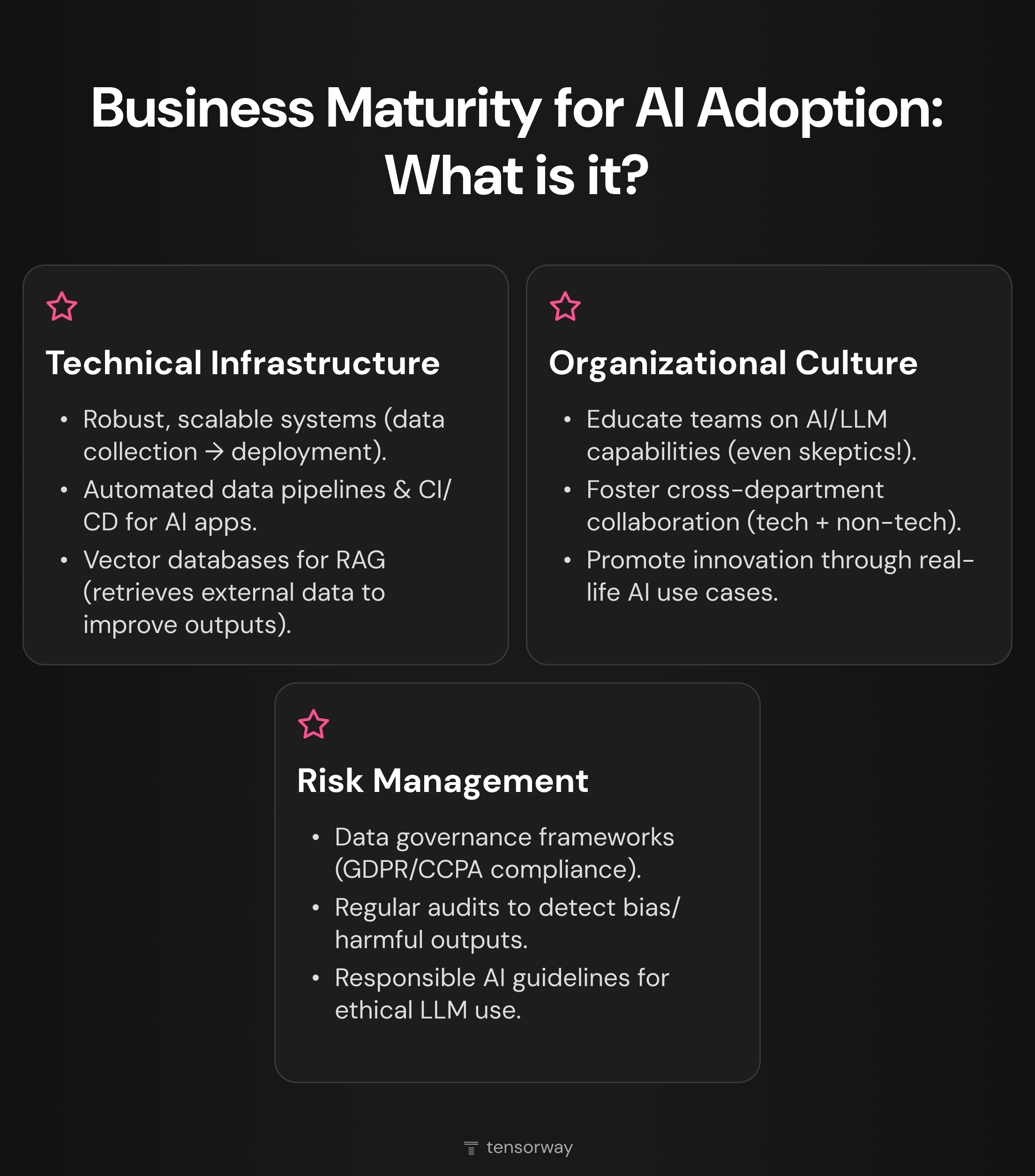The hype around Generative AI and significant advancements in this field are among the factors that encourage businesses to think about the implementation of solutions powered by large language models into their processes. But are all the companies that are planning LLM integration really ready for that? Before starting their AI journeys, the majority of organizations are too focused on their financial readiness, while ignoring another essential parameter. That’s business maturity.
The rush to adopt LLMs without assessing business maturity first can lead to significant setbacks, including technical failures, ethical issues, data security breaches, and internal resistance. These challenges can be even more complex when LLMs are embedded into broader software development projects. To avoid all these risks, businesses need to conduct a thorough assessment of their readiness to introduce AI-powered tools and workflows.
In this article, we are going to talk exactly about this. We will explain what business maturity for LLM integration means and provide practical recommendations on how to assess it.
Business Maturity for AI Adoption: What Is It?
Business maturity in the context of integrating AI tools and LLMs can be explained as a measurement of an organization’s strategic, technical, and operational readiness to effectively implement and scale such solutions. In this context, it’s vital to understand that business maturity is not only about technology. It is also about processes, teams, and culture.
In simple words, the assessment of your business maturity for LLM integration will help you to answer the question: “Are you ready for it or should you do anything else beforehand in order to avoid negative consequences?”.
Here are the key dimensions to be analyzed.

Technical Infrastructure
This is an integral part of any AI project. Mature businesses should have robust, scalable, and modular infrastructures that can support all stages of LLM implementation from data collection to model deployment and modernization.
Another important requirement is having data pipelines and well-established CI/CD processes for AI apps.
Apart from this, you should already have (or be ready for the introduction of) vector databases. They are essential for semantic search and Retrieval-Augmented Generation (RAG), which presupposes retrieving relevant info from external sources to generate answers based on that.
Organizational Culture
As for your team, first of all, your employees should have a good understanding of the AI/LLM possibilities. Even if you see that your employees are skeptical about LLM implementation, it doesn’t mean that you should give up. In this case, you need to educate people on the potential benefits of large language models for their work and demonstrate real-life AI applications.
You should support innovations and build closer collaboration between technical and non-technical teams.
Risk Management
Before implementing LLMs, businesses should stay aware of the fact that LLMs can generate wrong, biased, or even harmful outputs. That is why data governance becomes a must for mature businesses.
If you want to integrate large language models into your processes, you need to introduce frameworks for responsible AI use, take care of regulatory compliance, as well as make regular model audits an important part of your work.
Maturity Models for LLM Integration
When you start assessing your business maturity, you should not only understand whether you are ready for LLM implementation but also at what stage your business is.
There can be different approaches to terminology and stage determination. We offer the following one.
How to Assess Your Maturity for Integrating LLMs?
The assessment of the maturity of your organization for the adoption of large language models is a comprehensive process that requires considering your business from different perspectives. Our practical tips will help you make this process more efficient and result-oriented.

Step 1. Analysis of Your Current Business State
It is recommended to rely on a specifically prepared maturity assessment questionnaire to understand where your business stands at the moment.
The questions should cover different aspects.
- Team readiness. Do your employees understand AI and LLMs? Do they have any experience in interacting with large language models?
- Data governance. Are your solutions and activities compliant with data privacy regulations, like GDPR or CCPA? Do you follow any AI ethics frameworks?
- Data readiness. Is your data structured or unstructured? Do you have access to labeled data already?
- Tech stack. Do you use any LLMs? What types of databases are in use?
- LLM use cases. How are LLMs applied? What are the key purposes for their use? Do you rely on the RAG technique?
Step 2. Identification of Your Business Priorities
Based on the results of your diagnostics, you will need to define the areas with the biggest impact on your business maturity.
As a rule, such areas could be infrastructure, team composition and education, and data governance.
Step 3. Roadmap Development
You need to design a phased roadmap that will outline how to move from your current to the next maturity levels.
Each phase should include exact milestones and success metrics that will indicate your move to the next step, as well as required investments into new tools, infrastructure, and labor resources.
Step 4. Continuous Monitoring and Improvements
When your AI-powered solutions and LLMs are already implemented and being actively used, it doesn’t mean that your work related to them is over. To ensure their successful functioning, continuous monitoring of their performance and security becomes a must.
There are several key areas that you should focus on.
- LLM performance tracking. You need to check the quality of the model’s outputs in order to detect hallucinations, inaccuracy, and speed issues. Your employees’ feedback can become a valuable component of model monitoring.
- Data governance. LLMs are powered by data. That’s why a lot of risks are typically related either to the lack of control over the generated data or the insecure use and management of sensitive information. Given this, it is crucial to manage properly all the processes related to data, including its collection, storage, and usage in the context of training, fine-tuning, and deploying LLMs.
- Business KPIs. It is necessary to define and further analyze a set of KPIs that will demonstrate the efficiency of your AI efforts. For example, you may need to measure productivity gains, time savings, or improved client and employee satisfaction.
- Iterations. We recommend you implement the reliable iteration process, which will help you ensure that your LLMs continue to evolve over time and deliver measurable value. Based on your internal audits and feedback loops, it may be required to retrain or fine-tune your models to achieve better accuracy and efficiency of their outputs.
LLM Integration: Future Trends to Watch Out For
As the development of AI technologies, including deep learning and NLP, is going on, the landscape of LLM integration is evolving as well. While many organizations are still at the stage of early experimentation, some others are already focusing on long-term plans to embed AI algorithms and LLMs into their core workflows, services, and products. At our AI consulting company, we do our best to stay up to date with what is happening in this space. Now, we’d like to share our insights and we suggest you have a closer look at the LLM integration trends.
Multimodality
What are large language models in common understanding? They are solutions or tools that can understand our natural language and answer our requests much like a human can do. These models are a key milestone in NLP development, enabling more intuitive and efficient human-computer interaction. Nevertheless, the future of LLMs is not just textual. New models are becoming multimodal. It means that they are able to interpret and generate content in different formats, including not only text but also images, video, and audio. In one of our previously published articles, you can read more about multimodal systems.
LLM Fusion
This growing trend involves integrating multiple LLMs that are specialized in different domains or tasks into a single system. Thanks to this, businesses do not need to rely on just one general-purpose model. Instead, they can combine domain-specific LLMs, multimodal models, etc. For example, a single virtual assistant may use one model for preparing emails, another for summarizing legal documents, and a third one for sentiment analysis.
On-Premise Deployments and Edge AI
AI implementation is closely tied to a row of concerns about data privacy, latency, and regulatory compliance. Due to all this, a growing number of organizations are exploring on-premise or edge deployment of LLMs. This approach helps them leverage greater control over sensitive data. This is especially important in such industries as finance or healthcare. Apart from this, local deployment ensures the offline functionality of LLMs and their faster response times.
Business-wide Automation
Today large language models are mainly applied as isolated tools that solve specific tasks. However, in the near future, they will be transformed into fully integrated components of business processes. LLMs will become a part of end-to-end workflows and productivity software, including HR, ERP, and CRM platforms. These changes will require stronger AI and data management, as well as wider training initiatives to help teams adapt to entirely automated systems.
Such solutions are being implemented already today. For instance, for one of our clients, our team built an agentic system that supports the entire deal sourcing lifecycle. On our website, you can find more detailed information about this AI agent development project.
Wrapping Up
The introduction of large language models into business processes is not just a one-time technical upgrade. It is a serious transformation that touches every aspect of the business. Given this, before proceeding to active phases of LLM implementation, it is vital to assess business readiness for that.
Business maturity in LLM adoption evolves through several stages, from early experimentation to continuous improvements of AI-powered processes. Each stage requires specific capabilities and resources not just in infrastructure and tools, but also in mindset and governance.
If you need professional help in assessing your business maturity for LLM introduction or developing the best AI strategy, our professional consulting team will help you. Share your requirements with us and we will find the best solution for achieving your business goals.
FAQ
How much do LLM integration services cost?
The exact cost of such projects can vary based on many factors, including the chosen LLM provider, project complexity, and specific requirements. On average, LLM integration project budgets start at around $25K and can go significantly higher, especially when a company needs to develop its own custom large language model.
Can off-the-shelf LLMs be used or are custom models a must?
When it comes to choosing one of the available large language models or building your own, everything depends on your specific business needs and expectations. Off-the-shelf LLMs can be used for many applications and various general-purpose tasks like chatbots or content summarization. Custom models are required when your solutions deal with deep domain knowledge or highly specific processes.
What are the risks of ignoring maturity assessment before LLM integration?
If you ignore maturity assessment before integrating a large language model into your processes, this can lead to wasted resources, security and compliance issues. Besides, such a situation also increases the risk of implementing a solution that your tech infrastructure or team won’t be able to support effectively.
.jpg)
